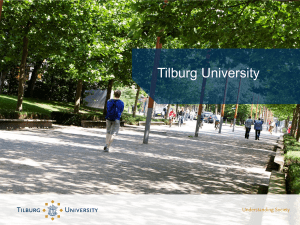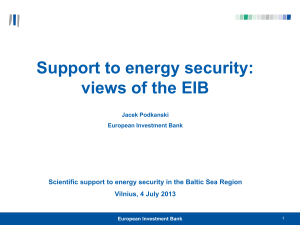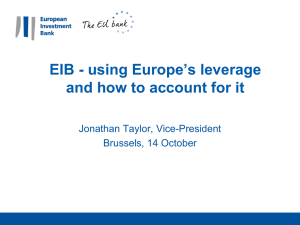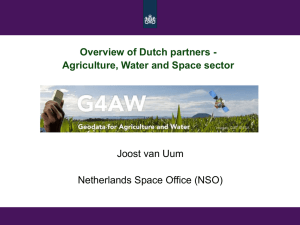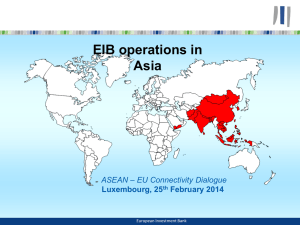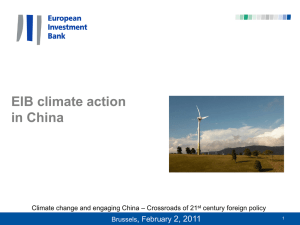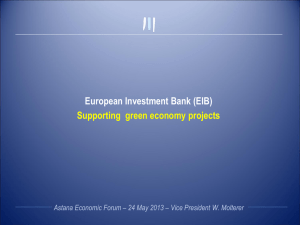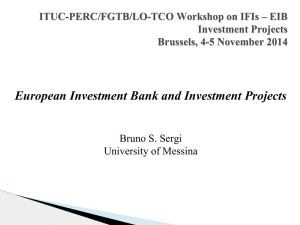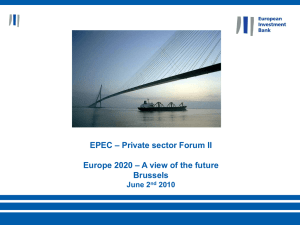speech delivered by Dirk Jan van den Berg
advertisement
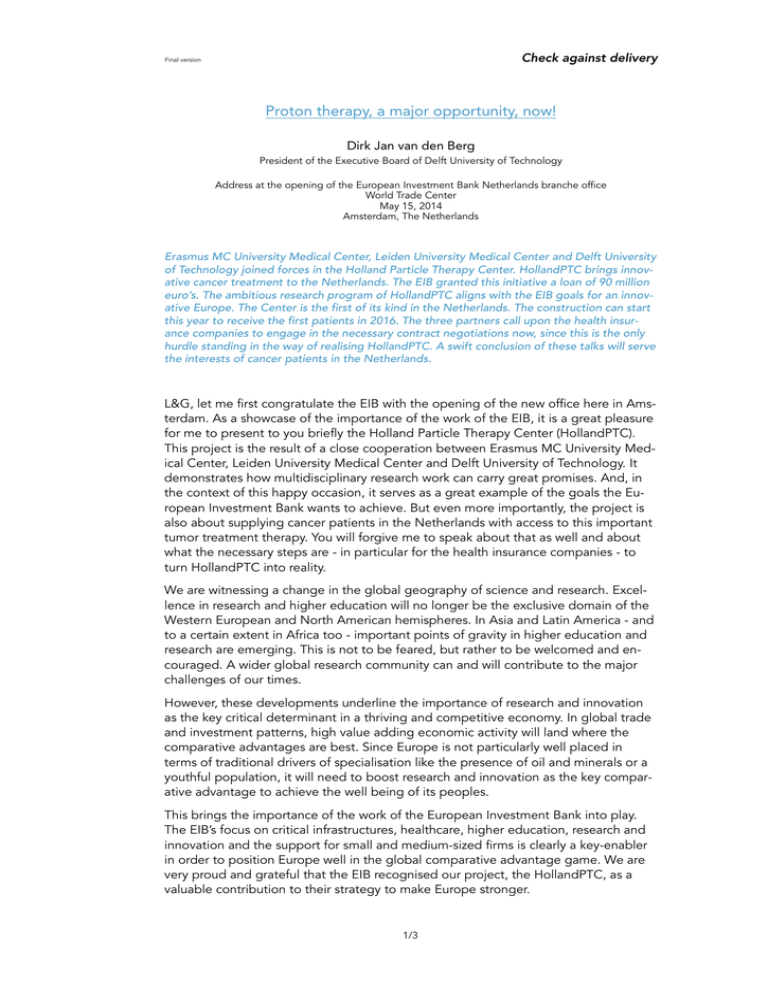
Check against delivery Final version ! Proton therapy, a major opportunity, now! ! !! Dirk Jan van den Berg President of the Executive Board of Delft University of Technology ! ! Address at the opening of the European Investment Bank Netherlands branche office World Trade Center May 15, 2014 Amsterdam, The Netherlands Erasmus MC University Medical Center, Leiden University Medical Center and Delft University of Technology joined forces in the Holland Particle Therapy Center. HollandPTC brings innovative cancer treatment to the Netherlands. The EIB granted this initiative a loan of 90 million euro’s. The ambitious research program of HollandPTC aligns with the EIB goals for an innovative Europe. The Center is the first of its kind in the Netherlands. The construction can start this year to receive the first patients in 2016. The three partners call upon the health insurance companies to engage in the necessary contract negotiations now, since this is the only hurdle standing in the way of realising HollandPTC. A swift conclusion of these talks will serve the interests of cancer patients in the Netherlands. ! L&G, let me first congratulate the EIB with the opening of the new office here in Amsterdam. As a showcase of the importance of the work of the EIB, it is a great pleasure for me to present to you briefly the Holland Particle Therapy Center (HollandPTC). This project is the result of a close cooperation between Erasmus MC University Medical Center, Leiden University Medical Center and Delft University of Technology. It demonstrates how multidisciplinary research work can carry great promises. And, in the context of this happy occasion, it serves as a great example of the goals the European Investment Bank wants to achieve. But even more importantly, the project is also about supplying cancer patients in the Netherlands with access to this important tumor treatment therapy. You will forgive me to speak about that as well and about what the necessary steps are - in particular for the health insurance companies - to turn HollandPTC into reality. We are witnessing a change in the global geography of science and research. Excellence in research and higher education will no longer be the exclusive domain of the Western European and North American hemispheres. In Asia and Latin America - and to a certain extent in Africa too - important points of gravity in higher education and research are emerging. This is not to be feared, but rather to be welcomed and encouraged. A wider global research community can and will contribute to the major challenges of our times. However, these developments underline the importance of research and innovation as the key critical determinant in a thriving and competitive economy. In global trade and investment patterns, high value adding economic activity will land where the comparative advantages are best. Since Europe is not particularly well placed in terms of traditional drivers of specialisation like the presence of oil and minerals or a youthful population, it will need to boost research and innovation as the key comparative advantage to achieve the well being of its peoples. This brings the importance of the work of the European Investment Bank into play. The EIB’s focus on critical infrastructures, healthcare, higher education, research and innovation and the support for small and medium-sized firms is clearly a key-enabler in order to position Europe well in the global comparative advantage game. We are very proud and grateful that the EIB recognised our project, the HollandPTC, as a valuable contribution to their strategy to make Europe stronger. !/! 13 !1 Check against delivery Final version Let me briefly explain the importance of proton therapy. It is sad but true, worldwide, more than 8 million people die annually as a result of cancer. In our country, the proportion of adults affected by cancer, as well as the number of patients dying due to cancer increases every year. Traditional radiotherapy with photons seriously risks to affect the healthy tissues surrounding the tumor. The advantage of a therapy with small particles instead of light, with protons, is the ability to much better direct the beam into the center of the tumor. In addition, protons will travel through the body only to unleash their power reaching the tumor, without causing serious harm during their trajectory. These characteristics makes proton therapy a very crucial treatment opportunity for a whole range of tumors, in particular those located in the vicinity of vital structures. This includes head and neck cancer, tumors of the brain, eye-tumors, and most likely other tumors in other structures as the pancreas. One doesn't need to be a doctor to understand that collateral damage in the neck and the head can be very dangerous and even prohibitive to receiving conventional radiotherapy at all. Our initiative will allow us to be part of a global research network involving partners in the USA and Canada, focusing on research holding the promise for optimizing the treatment. We are very welcome, since the Erasmus MC University Medical Center houses world level experts and researchers in the area of head and neck cancers, while the Leiden University Medical Center is a globally renowned eye tumor center. The cooperation between two university medical centers and a university of technology will allow us to execute a unique and ambitious research agenda focusing on the improvement of proton delivery into the tumor. Imagine real time position monitoring and control of proton pencil beams making sure protons will be delivered right into the tumor. If we succeed, it will mean a world-wide breakthrough in the treatment of cancers. We are very grateful that the EIB recognised and appreciated the importance of our research agenda. In fact, it has been the crucial argument for the EIB to select HollandPTC as its only partner in the Netherlands in the development of proton therapy. The EIB has put words into action and granted us a loan of 90 million euros. Success will bring Europe at the highest level of global research and innovation on radiation therapy for the treatment of cancer. The application driven nature of our research will open up commercial opportunities as well. Up until now I spoke about our initiative as if it was only designed to please researchers, policymakers and businesses. Nothing could be further from the truth. We are very driven to offer this new and highly promising therapy to cancer patients in the Netherlands and to bring our national offering of this therapy at par and beyond with countries like Germany, Switzerland, France, Italy and the UK. We have completed all the preparations so we can start to build this year enabling us to receive our first patients in 2016. We are strongly committed to bring this groundbreaking therapy to cancer patients in the Netherlands. Why keep patients in the Netherlands waiting? The healthcare system in the Netherlands requires a contractual agreement between health care facilities, and the health insurance companies on tariffs and number of treatments. We have presented the insurers with a turnkey project, that can start today, that, with the EIB financing, requires no other investments than from the 3 partners involved. We propose competitive tariff levels, embedded in a restrictive business case. Incidence of cancers in the Netherlands for which proton therapy is an established treatment greatly surpasses the planned capacity in our project. There is room for the 3 other initiatives. They are in different stages of development however, none of them ahead of us, nor carrying a research agenda of similar depth. !/! 23 !2 Check against delivery Final version We have requested the Ministry of Health, Wellbeing and Sports to allow HollandPTC to treat children as well. There is no scientific argument of any sort not to agree to that. All the more because currently Dutch children are now being treated in Centers abroad totally similar in setup to HollandPTC, so why not allow here in the Netherlands what we accept elsewhere. This would enable us to include the - fortunately very few paediatric patients (2 pct of the total incidence) in the Netherlands as well. We appreciate the budgetary predicaments health insurers are confronted with, but that is exactly why our proposition is a no-brainer. The logical thing for the insurers to do is to take up the first initiative that is ready - HollandPTC to be precise - and then to further develop capacity in the Netherlands along the line of readiness of proposals. This approach is very much in the interest of cancer patients in the Netherlands. Their well-being is, after all, the driving inspiration of our work. One wonders what is taking the insurers so long. Forgoing on this opportunity would be against the interest of cancer patients and would divorce the Dutch research community from world class research and innovation opportunities in a very crucial area of health care and wellbeing. Let me conclude by thanking the EIB for the trust invested in our project. One could think of no better signature project, combining many objectives of the EIB in one single undertaking. We hope and expect to build HollandPTC, for the benefit of cancer patients, for the further advancement of research in cancer treatment and for the education of future doctors and researchers to challenge cancer. ! **** !3 !/! 33

